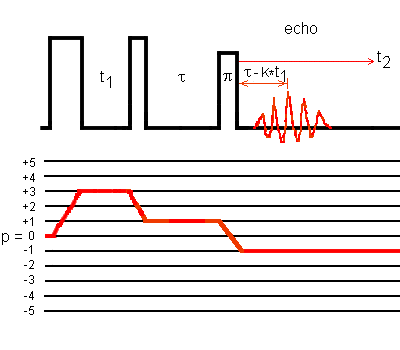
Cogwheel phase cycling in I = 5/2, 3 pulses,
3QMAS phase-modulated shifted-echo pulse program.
Contribution of Y. Millot

Cogwheel phase cycling in I = 5/2, 3 pulses,
3QMAS phase-modulated shifted-echo pulse program.
Contribution of Y. Millot

Below NMR pulse program describes the phase-modulated shifted-echo for (1D and 2D) +3Q-MAS experiment applied to quadrupolar nuclei with half-integer spin I = 5/2.
Strong pulses allow a better excitation of off-resonance spins.
This NMR pulse program is for Bruker Avance spectrometers.
After the Fourier transform with respect to t2, a tau-dependent first-order phase correction is performed to remove the phase modulation due to the shift and a t1-dependent first-order phase correction to perform the shearing transformation.
; cogwheelmp3qShiftE ; 3Q MAS pulse program for I = 5/2 nuclei ; cogwheel phase-modulated shifted-echo ; 3-pulse experiment with full echo acquisition: ; excitation(3Q) - conversion(1Q) - tau - 180° - acquisition(-1Q), ; uses cogwheel phase cycling with alternating phases of the first pulse ; and that of the receiver ; cog51(-5, 0, 3; 21) === cog51(-26, -21, -18; 0) ; === cog51(25, 30, 33; 0) ; alternating the phases of the second pulse and those of the third pulse do ; not change the sign of the echo signal ;NS : 51*n ;d1 : recycle delay ;p1 : excitation pulse at pl11 ;p2 : conversion pulse at pl11 ;p4 : 180 degree pulse at pl21 ;cnst31 : MAS spin rate ;pl1 : = 120 db ;pl11 : power level ;pl21 : power level ;d6 : to allow full echo to build up ;l1 : number of rotor cycles for whole echo ;d0 : = 3u or longer ;in0 : 1 rotor period for synchronised experiment ;td1 : number of t1-experiments ;FnMODE : QF ;MC2 : QF "d6=((1s*l1)/cnst31)-(p2/2)-(p4/2)" ; set the delay d6 according to l1 and cnst31 ; values by the spectrometer automatically, ze ; clear memory, new data replace old data, ; switch AD converter to replace mode, ; perform DS before next acquisition, 1 d1 ; recycle delay, 10u pl11:f1 ; 10 microsecond delay, ; set high power in f1 channel, (p1 ph1):f1 ; high-power excitation pulse, d0 ; delay between pulses, t1 increment, (p2 ph2):f1 ; high-power conversion pulse, d6 ; delay tau calculated automatically, (p4 pl21 ph3):f1 ; low-power 180° pulse, go=1 ph31 ; signal acquisition, ; loop to 1, NS times for averaging, 2 d1 ; recycle delay, 10u pl11:f1 ; 10 microsecond delay, ; set high power in f1 channel, (p1 ph4):f1 ; high-power excitation pulse, d0 ; delay between pulses, t1 increment, (p2 ph2):f1 ; high-power conversion pulse, d6 ; delay tau calculated automatically, (p4 pl21 ph3):f1 ; low-power 180° pulse, go=2 ph30 ; signal acquisition, ; loop to 2, NS times for averaging, d1 mc #0 to 1 F1QF(id0) ; delay for disk I/O, store signal, ; increase FID number, ; delete memory data, ; do not perform dummy scans ; with next acquisition, ; increment time d0 by in0, exit ; end of the pulse program ph10=(51) 0 1 2 3 4 5 6 7 8 9 10 11 12 13 14 15 16 17 18 19 20 21 22 23 24 25 26 27 28 29 30 31 32 33 34 35 36 37 38 39 40 41 42 43 44 45 46 47 48 49 50 ; standard phase, ph11 = 2 ; 180° phase for changing ; the phase of 1st pulse ph1 = ph10*25 ; excitation pulse phase, ph4 = ph1 + ph11 ; opposite excitation pulse phase, ph2 = ph10*30 ; conversion pulse phase, ph3 = ph10*33 ; 180° pulse phase, ph31 = 0 ; receiver phase, ph30 = 2 ; opposite receiver phase